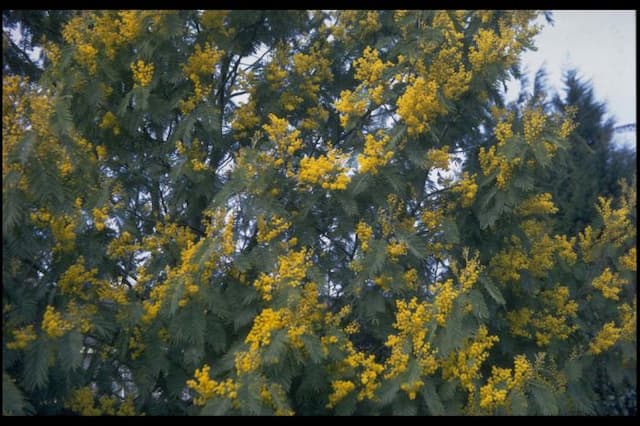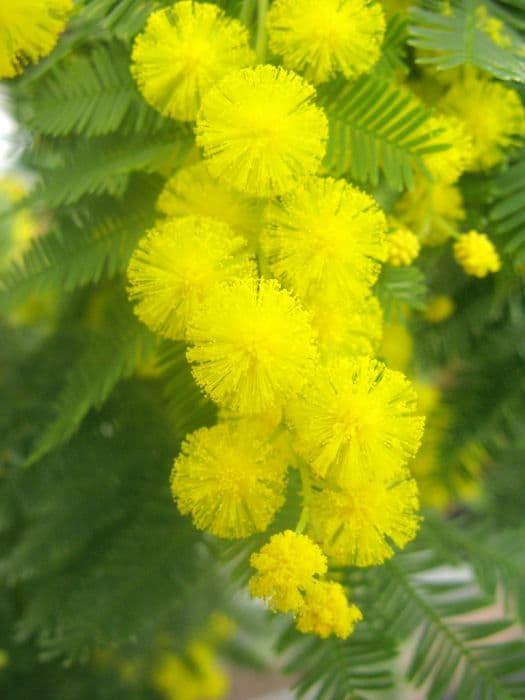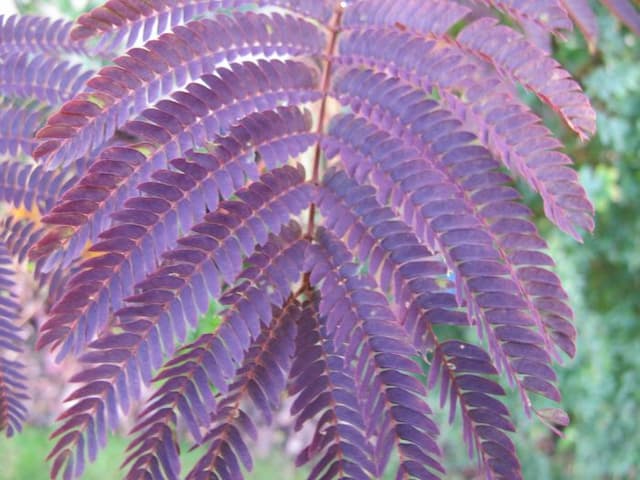Lena Broom Cytisus 'Lena'

ABOUT
Cytisus 'Lena', commonly known as Lena Broom, is a deciduous shrub characterized by its vibrant, multi-hued flowers and arching stems. During its blooming period, typically in late spring to early summer, Lena Broom becomes a spectacular display with its blossoms that blend hues of red, yellow, and orange. These small, pea-like flowers are profuse and cover the plant, creating a striking contrast against its green foliage. The leaves of the Lena Broom are small and trifoliate, meaning each leaf is composed of three leaflets, which are narrow and have a somewhat delicate appearance. As the season transitions to fall, the leaves may turn yellow before they drop, adding another layer of seasonal interest. The overall shape of the plant is rounded and slightly weeping, with the slender branches contributing to its informal and relaxed appearance. This graceful structure makes the Lena Broom a welcome addition to garden landscapes, particularly fit for borders or as a colorful specimen plant. Lena Broom's ornamental qualities are amplified by its ruggedness and ability to thrive in a variety of soil conditions, given that it receives sufficient sunlight. Its adaptability and the profusion of strikingly colorful flowers make it a favored choice among gardeners looking to add a splash of warmth and color to their outdoor spaces.
About this plant
 Names
NamesSynonyms
Lena Broom
Common names
Cytisus 'Lena'.
 Toxicity
ToxicityTo humans
Lena Broom is a plant that contains toxic alkaloids known as sparteine and isocytisine, which can be particularly harmful if ingested. The toxicity of this plant could lead to various symptoms if a person consumes any part of it. These symptoms can range from mild to severe and might include nausea, vomiting, abdominal pain, dizziness, and confusion. In more serious cases, consuming Lena Broom can lead to respiratory failure and convulsions. Immediate medical attention should be sought if poisoning is suspected.
To pets
Lena Broom, similar to its effects on humans, is toxic to pets due to the presence of alkaloids such as sparteine and isocytisine. If a pet, such as a dog or a cat, ingests any part of this plant, it may exhibit signs of poisoning that can vary in severity. Symptoms might include vomiting, diarrhea, salivation, weakness, and incoordination. In more severe cases, it can lead to changes in heart rhythm, seizures, and possibly even death. Therefore, it is crucial to keep this plant out of reach of pets and seek veterinary care immediately if poisoning is suspected.
 Characteristics
CharacteristicsLife cycle
Perennials
Foliage type
Deciduous
Color of leaves
Green
Flower color
Mixed
Height
4 feet (1.2 meters)
Spread
4 feet (1.2 meters)
Plant type
Shrub
Hardiness zones
6
Native area
Europe
Benefits
 General Benefits
General Benefits- Attracts Pollinators: Cytisus 'Lena' is known to attract bees and other pollinating insects, which is beneficial for the garden ecosystem.
- Drought Tolerance: Once established, this plant has a good tolerance for dry conditions, requiring less water compared to many other plants.
- Low Maintenance: The Lena Broom is generally easy to care for, requiring minimal upkeep, which is ideal for busy gardeners or those new to gardening.
- Fast Growth: This plant grows relatively quickly, providing rapid coverage or filling in spaces in the landscape.
- Colorful Blooms: The shrub produces vibrant yellow and red flowers that add a splash of color to any garden setting.
- Soil Adaptability: It can adapt to a wide range of soil types, although it prefers well-drained soils.
- Deer Resistance: The Lena Broom is not particularly attractive to deer, reducing the risk of damage from wildlife in rural gardens.
- Compact Size: With its relatively small and compact growth habit, it fits well in smaller gardens or spaces.
- Erosion Control: This plant can be used on slopes or areas prone to erosion, helping to stabilize the soil.
- Versatility: It can be used in a variety of landscaping applications, including borders, groundcovers, or as a standalone specimen.
 Medical Properties
Medical PropertiesThis plant is not used for medical purposes.
 Air-purifying Qualities
Air-purifying QualitiesThis plant is not specifically known for air purifying qualities.
 Other Uses
Other Uses- Wildlife Habitat: Cytisus 'Lena', also known as Broom, can provide shelter and nesting sites for birds and beneficial insects due to its dense foliage.
- Erosion Control: Broom plants are often used on slopes and banks to help stabilize soil and prevent erosion.
- Dye Production: The flowers of the Broom can be used to create yellow dyes for textiles.
- Tannin Source: The bark of the Broom plant contains tannins that can be used in the tanning process of leathers.
- Fragrance Extraction: Broom flowers have a strong, sweet scent and are sometimes used in the production of perfumes and scents.
- Biomass Fuel: Broom species can be cultivated for biomass fuel because of their rapid growth and high biomass yield.
- Crafts and Baskets: The flexible branches of Broom can be used for weaving baskets and other crafts.
- Landscaping: Due to its attractive flowers and foliage, Broom is used for ornamental purposes in gardens and parks.
- Hedging: Broom can be trimmed and maintained as a natural hedge, providing boundaries and privacy in garden settings.
- Soil Improvement: Broom plants have the ability to fix nitrogen in the soil, which can improve soil quality for other plants.
Interesting Facts
 Feng Shui
Feng ShuiThe Scotch Broom is not used in Feng Shui practice.
 Zodiac Sign Compitability
Zodiac Sign CompitabilityThe Scotch Broom is not used in astrology practice.
 Plant Symbolism
Plant Symbolism- Renewal: The Cytisus 'Lena', or Scotch Broom, is known for its capacity to rejuvenate and adapt to various conditions, making it a symbol of new beginnings and regeneration.
- Protection: In folklore, the Scotch Broom was thought to have protective qualities, warding off evil and negativity when planted around a home.
- Humility: Despite its vibrant appearance, the Scotch Broom is a simple plant that grows in challenging environments, representing humility and modesty.
- Cleansing: Historically, its branches were used for sweeping, associating the plant with cleanliness, both physical and spiritual.
 Water
WaterLena Broom should be watered regularly, especially during its first growing season to establish a deep, extensive root system. Once established, they are relatively drought tolerant and require less frequent watering. During the growing season, watering every 7 to 10 days with approximately 1 to 1.5 gallons of water should suffice, depending on the soil and climate conditions. Always check the top inch of soil for dryness before watering; if it feels dry, it's time to water. In the winter, reduce watering to prevent root rot, especially if the plant is in an area that receives rainfall.
 Light
LightLena Broom thrives best in full sun conditions where it can receive at least 6 to 8 hours of direct sunlight daily. A spot that is south-facing is ideal for this plant because it ensures maximum exposure to sunlight. However, it can also tolerate partial shade, although blooming may be less abundant in reduced light conditions.
 Temperature
TemperatureLena Broom prefers temperate climates and will do well in temperatures between 40 and 80 degrees Fahrenheit. They can survive brief periods of colder weather down to about 20 degrees Fahrenheit, but extended exposure to severe frost can be damaging. The ideal temperature range for promoting healthy growth is between 50 and 75 degrees Fahrenheit during its active growing season.
 Pruning
PruningLena Broom should be pruned to maintain its shape and encourage bushier growth. The best time to prune is immediately after flowering to avoid cutting off the next year's buds. Prune lightly each year, removing dead or weak branches and cutting back about a third of the old stems to promote new growth. Frequent, heavy pruning is not necessary and can be detrimental to the plant.
 Cleaning
CleaningAs needed
 Soil
SoilLena Broom prefers well-draining soil with a pH level of 6.0 to 7.5. A mix of sandy loam, peat, and coarse sand in equal parts is ideal for providing the necessary drainage and aeration.
 Repotting
RepottingLena Broom typically does not require frequent repotting. It should be repotted every two to three years to refresh the soil and resize the pot if necessary.
 Humidity & Misting
Humidity & MistingLena Broom thrives in moderate humidity levels but is quite adaptable and can tolerate a range of humidity conditions found in typical outdoor environments.
 Suitable locations
Suitable locationsIndoor
Place in bright light, away from direct heat sources.
Outdoor
Full sun, sheltered from strong winds; well-drained soil.
Hardiness zone
6-9 USDA
 Life cycle
Life cycleCytisus 'Lena', commonly known as Lena Scotch Broom, begins its life cycle as a seed, typically germinating in late winter or spring when temperatures become favorable. After germination, the seedling stage is characterized by the emergence of the first true leaves, as the plant establishes a root system. As it enters the vegetative stage, Lena Scotch Broom experiences rapid growth, producing a woody stem and multiple branches, with leaves developing into small, green ovals. During the reproductive stage, usually in late spring to early summer, it displays vibrant yellow and red flowers that attract pollinators. After pollination, seed pods develop and mature, turning black as they dry and eventually bursting open to disperse seeds. As a perennial, Lena Scotch Broom can undergo several reproductive cycles, with individual plants often living and flowering for several years before they eventually die.
 Propogation
PropogationPropogation time
Spring-Early Summer
The Scotch Broom 'Lena', known for its vibrant blooms, can be propagated through various methods, but the most popular way is through semi-hardwood cuttings. This typically occurs during the late summer months. For best results, a cutting of about 4-6 inches (10-15 cm) long should be taken from a healthy part of the plant. The lower leaves are then stripped, and the cutting is dipped into rooting hormone to encourage new growth. This treated cutting is then planted in a mix of peat and perlite to provide an environment conducive to root development. The container should be kept in a warm place with indirect light and consistent moisture until the roots have formed, after which it can be transplanted into a pot or garden setting.









